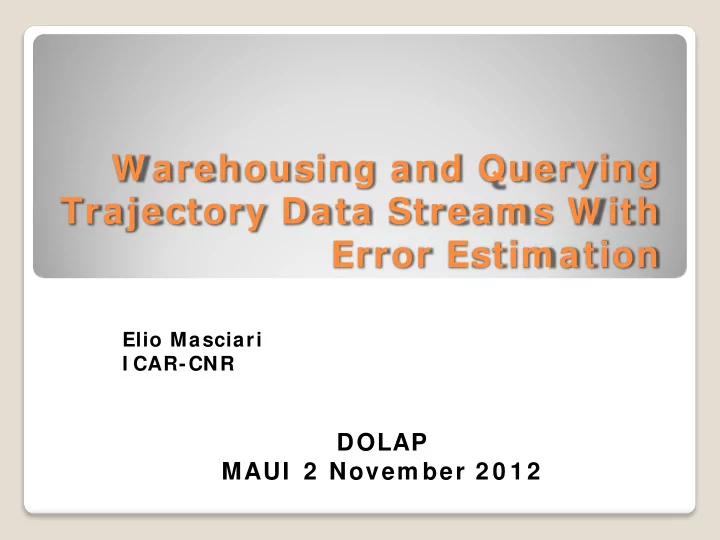

W arehousing and Querying Trajectory Data Stream s W ith Error Estim ation Elio Masciari I CAR-CNR DOLAP MAUI 2 Novem ber 2 0 1 2
Trajectory Data Prime Numbers Encoding for Paths Warehousing Steps Experimental Evaluation Conclusions Outline
Data Pertaining to time and position of moving objects ◦ GPS systems ◦ Traffic management Two dimensional ◦ In general partitioning is a well accepted solution Segmentation Regioning Trajectory Data
Trajectory Data
Regioning ◦ IPCA: Identifies Preferred Directions for Data ◦ Differential Regioning Prime Number Encoding: ◦ Trajectories represented as products of prime numbers Our Solution: Regioning+ Encoding
Regioning: regions close to principal directions are finer
T1 = ABC crossing three regions A,B,C. Assign to regions A, B and C respectively the prime numbers 3,5,7 For trajectory T1 the witness W1 is 52 since 52% 3 = 1 = pos(A) and 52% 5 = 2 = pos(B) and 52% 7 = 3 = pos(C) Store the encoded trajectories using a binary tree Encoding: prim e num bers
Building Specialized cuboids: TRAC ◦ Distinct Count Problem Measures ◦ the number of distinct trajectories ( Intersections), ◦ the average traveled distance (Distance), ◦ the average time interval duration ( Duration) Trajectory W arehousing
Precomputed cuboids pertaining to most interesting recent data Merging cuboids at different granularity levels when needed Iceberg assumption TRACs
Perform ances
Perform ances
Perform ances
Perform ances
Data reduction by regioning Efficient Queying via Encoding Warehousing in order to allow trajectory querying effectively Good performances ◦ Accuracy ◦ Efficiency Conclusions
Recommend
More recommend